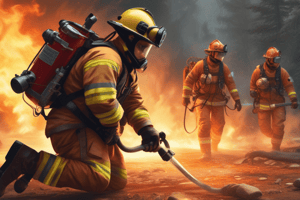Podcast
Questions and Answers
What is a key component of firefighter training in terms of physical requirements?
What is a key component of firefighter training in terms of physical requirements?
- Administrative tasks and paperwork
- Cardiovascular exercises, strength training, and agility drills (correct)
- Fire behavior and dynamics analysis
- Mental preparation for emergency situations
During firefighter training, what is the primary focus of emergency response training?
During firefighter training, what is the primary focus of emergency response training?
- Fire behavior and dynamics analysis
- Technical skills such as equipment operation
- Decision-making, communication, and teamwork (correct)
- Physical conditioning and fitness
What is a key aspect of fire prevention in terms of electrical safety?
What is a key aspect of fire prevention in terms of electrical safety?
- Keeping a fire extinguisher nearby
- Using certified appliances and keeping cords away from heat sources (correct)
- Overloading outlets to save energy
- Installing smoke detectors in every room
What is the primary purpose of fire escape planning?
What is the primary purpose of fire escape planning?
What is the correct method for using a fire extinguisher?
What is the correct method for using a fire extinguisher?
Why is it important to maintain fire extinguishers regularly?
Why is it important to maintain fire extinguishers regularly?
Flashcards are hidden until you start studying
Study Notes
Firefighter Training
- Physical Requirements:
- Firefighters must be physically fit to perform demanding tasks in emergency situations
- Training includes cardiovascular exercises, strength training, and agility drills
- Technical Skills:
- Firefighters learn various techniques for extinguishing fires, including:
- Fire behavior and dynamics
- Hazardous materials response
- Rescue and emergency medical procedures
- Training includes hands-on practice with equipment and simulation exercises
- Firefighters learn various techniques for extinguishing fires, including:
- Emergency Response:
- Firefighters learn to respond to various emergency scenarios, including:
- Structural fires
- Wildland fires
- Vehicle fires
- Medical emergencies
- Training emphasizes decision-making, communication, and teamwork
- Firefighters learn to respond to various emergency scenarios, including:
Fire Safety
- Fire Prevention:
- Electrical Safety: Avoiding overloaded outlets, using certified appliances, and keeping cords away from heat sources
- Kitchen Safety: Never leaving cooking unattended, keeping a lid nearby, and turning off the stove when not in use
- Fireplace Safety: Keeping flammable materials away, having a fire screen, and ensuring proper ventilation
- Fire Escape Planning:
- Identifying Escape Routes: Designating at least two ways out of each room, especially bedrooms
- Practicing Drills: Conducting regular fire drills with household members to ensure preparedness
- Staying Low: Crouching or crawling to avoid smoke and toxic fumes
- Fire Extinguishers:
- Types of Extinguishers: Water, foam, dry chemical, and carbon dioxide extinguishers for different types of fires
- Proper Use: Following the PASS method: Pull, Aim, Squeeze, and Sweep
- Regular Maintenance: Inspecting and maintaining extinguishers according to manufacturer instructions
Studying That Suits You
Use AI to generate personalized quizzes and flashcards to suit your learning preferences.




